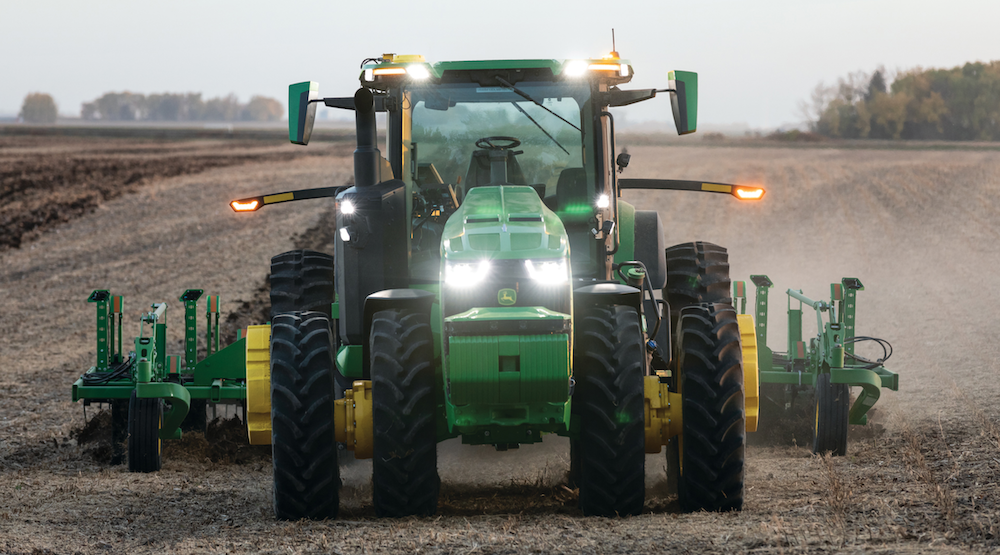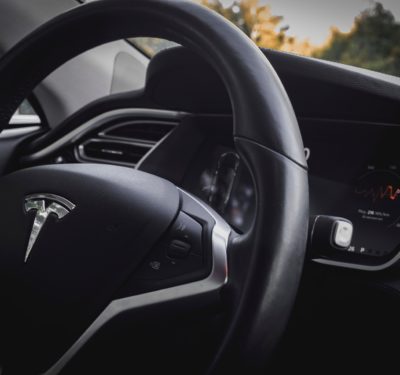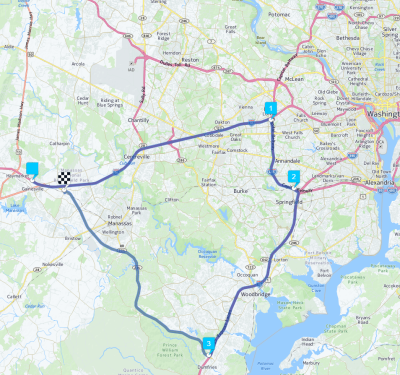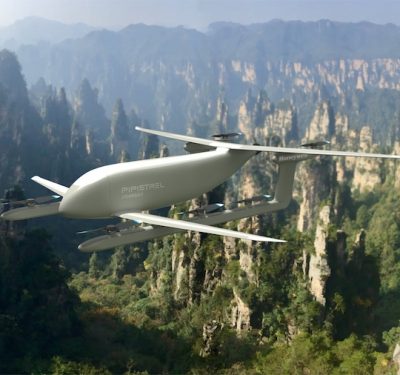
The John Deere autonomous tractor. Photo courtesy of John Deere & Company.
“The farm is a high-tech operation.”
So said Jahmy Hindman, chief technology officer, Deere & Company, as executives of the global agricultural-equipment firm took to the floor of the Consumer Electronics Show (CES 2022) in Las Vegas Tuesday, announcing a fully autonomous tractor ready for large-scale production that will roll out later this year.
Moline, Illinois-based John Deere sees the tractor as a response to the three major challenges facing farmers today: finding skilled labor, getting farming tasks done when they need to be done, and producing consistent results.
The machine, a significant advance in autonomous tillage, combines Deere’s 8R tractor, a TruSet-enabled chisel plow, a GPS guidance system and new technologies. Using stereo cameras, sensors, fast processors, a neural network system, AI and machine learning, the tractor is capable of real time data sharing, remote monitoring and management. It’s essentially “trained” by drawing on more than 50 million images.
In presentations punctuated by videos, the Deere executives framed the rollout as a major step toward the overall purpose of feeding the world. Global food demand is expected to rise 50 percent by 2050. At the same time, farming faces labor shortages, changing climate, shrinking available land and other challenges that threaten agriculture’s ability to meet that demand.
Unlike previous tractors, which could steer themselves but still required an operator in the cab, the new tractor is autonomous—it can run 24/7—freeing the farmer for other management tasks. It also creates time for family and quality of life—a rare commodity amid a farmer’s often 18-hour days. Though the farmer is not on or in the tractor though, he or she is always in touch—through mobile-device software that provides access to live video, images, data and metrics to adjust speed, depth, monitoring of anomalies and more.
“The Future of Farming Starts Today”
“It’s really quite amazing what a farmer can do”, said Jorge Hereud, director, automation and autonomy, who provided three use examples. During planting, ultra-precise GPS enables very straight rows and placing each seed in exactly the space it needs. During the growing season, cameras on the sprayers allow for applying only as much product as needed (saving up to 80% of costs). During harvesting, cameras in the combine can identify and adjust for crop conditions. “It allows farmers to increase productivity, profitability and sustainability,” Hereud said. “This is why I’m confident that the future of farming starts today.”
“I have been waiting for this moment my entire life,” Hindman added. “Until recently farming has been about doing more with more—more horsepower, more acreage—but the new digital era is changing all of that. The last decade has been about doing more with less.” He noted innovations such as Deere’s See and Spray Select, launched last March to differentiate between a seed and a weed, “is taking precision agriculture to a whole new level.”
Speaking via video, fourth-generation Minnesota farmer Doug Namz voiced benefits from his side of the field.
“When I started farming there basically was no technology,” said Namz, who grows approximately 2000 acres in corn and soybeans, and has been working with Deere as the tractor was developed. “For me it was really exciting the first time I got to take the autonomous tractor to the field, swipe my phone, watch the tractor start with no one in the cab and start doing tillage just as well as I could do myself.”
A Marvel of Brains and Brawn
“It’s a marvel of brains and brawn,” said Deeana Kovar, vice president, production and precision agriculture. Growing up on her family’s farm, there was so much to do that, though Kovar was the least-skilled operator, she would do chores like tillage to free her dad and uncle for tasks requiring more know-how. “While the jobs I did back then got done, I’m sure they didn’t get done just right,” she said. “That’s why automation and now autonomy are so critical to productivity and sustainability.”
“Fundamentally robots need to be able to do two things,” added Willy Pell, vice president of autonomy and new ventures. “They need to be able to perceive their environment and make a decision about what they perceive.”
“This tractor has six pairs of stereo cameras,” he continued, “which give the tractor the ability to work like the human eye.” The cameras stitch the images together as the training process rewards it for correct actions and penalizes for error. It also can detect anomalies such as something fallen in its path, he added.
“The farmer only has to transport the tractor to the field and configure it for autonomous operation,” said Julian Sanchez, a Deere director of emerging technologies. “They pull out their phone, swipe from left to right and the machine starts. At that point, the farmer is free to leave (the tractor).”
According to Deere, the autonomous future has begun.






